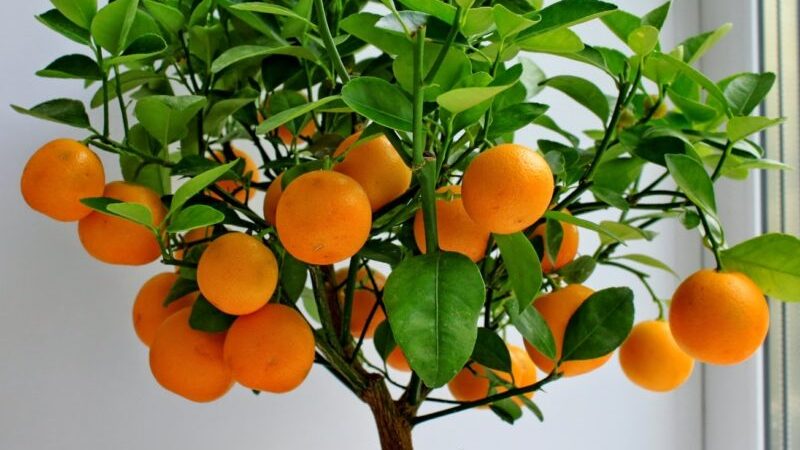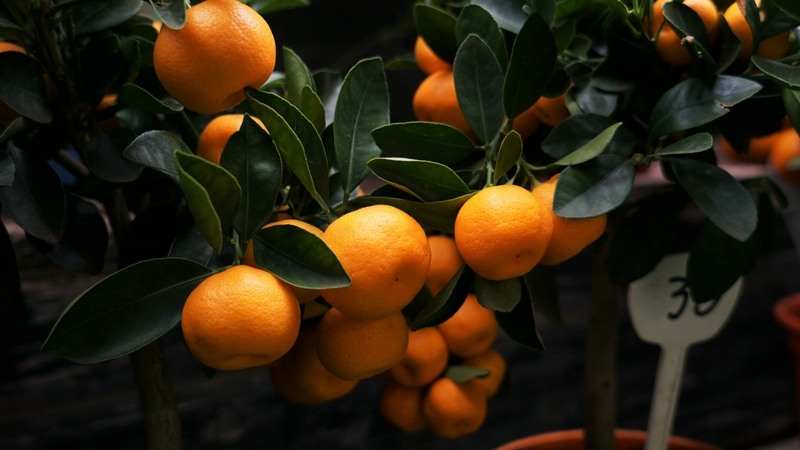The best food for the tangerine tree at home
Mandarin is an evergreen citrus tree. With proper care, it can yield delicious fruits even at home. How to care for this plant and how to feed a tangerine tree at home, we will tell further.
The content of the article
Homemade tangerine care rules
Tangerine tree in indoor conditions forms a compact flowering tree. Healthy tangerine has a decorative function in the interior, and during the flowering period it intensively releases aromatic substances.
Optimal conditions

Mandarins are demanding for light and warmth. Budding, flowering and tying of mandarins occur at an average temperature of + 15 ... + 18 ° С. In winter, the culture is kept in a bright and cold room at a temperature of + 12 ... + 13 ° C. Mandarin does not tolerate the lack of a change of seasons and stops bearing fruit. Therefore, a pot with a tree must be placed in a cool room.
The tree responds well to bright, diffused light near an east or west window. Mandarin content is allowed on the north side. In the summer, the sprout is shaded from aggressive sunlight, which burns the leaves. To do this, the bush is wrapped in wet gauze or waxed paper is glued to the window.
To increase daylight hours in winter, fluorescent lamps are installed above the pot. The optimal daylight hours for citrus fruits in winter are 8-9 hours.
Watering
Summer and spring plant watered abundantly daily with warm water. In winter, the amount of watering is reduced to 1-2 times a week, irrigated only with warm water. Overdrying an earthen coma in winter leads to the loss of leaves and fruits and even the death of the plant.
Attention! From excess moisture in winter, citrus fruits die, therefore, watering is reduced from October.
Mandarin is sensitive to air humidity, so regular spraying from a spray bottle has a good effect on the state of the vegetative system. Plants kept in rooms with central heating are sprayed daily.
Placing a wide bowl of water next to the radiator helps regulate humidity.
Pruning
Mandarin needs in crown molding, because in the wild the plant reaches 4-5 m in height... Having reached a height of 45-50 cm, the seedling often branches on its own. Pinching helps to stimulate the formation of lateral shoots of the first order.
After 4-5 leaves the next year, all the shoots are pinched again to stimulate the formation of shoots of 4-5 orders, on which fruiting occurs.
If desired, the mandarin crown is given a round, oval, teardrop shape.
Transfer

Until the onset of three years of age, trees are transplanted annually, then every 2-3 years. The transplant is carried out in mid-March, before the onset of active vegetation processes.
The plant is buried so that the root collar is at ground level. The root ball is transferred carefully, since the tangerine may die due to damage to the root system.
When transplanting an adult plant, each time a pot is chosen with a diameter of 4-5 cm larger than the previous one, for free growth and development of roots.
Attention! Do not transplant tangerines into a pot that is too large. Under such conditions, the root system does not have time to form a dense earthen ball, which leads to acidification of the soil and the death of the sprout.
The soil
The best soil for a tree It is considered a light peat substrate for citrus fruits or a versatile earthy mix. Young and mature plants need different quality soil composition.
Prepare the soil yourself as follows:
- for the first planting: 2 parts of turf, 1 part of leafy soil, 1 part of humus and 1 part of sand;
- for adult plants: 3 parts turf, 1 part leaf, 1 part humus, 1 part sand and 0.5 part clay.
At the bottom of the pot for citrus trees, drainage 1-3 cm high is always poured (depending on the age of the plant). Trees older than 7 years are not transplanted, but the top layer is renewed annually by 1/3 of the pot.
How to feed homemade tangerine
Housewives strive to feed indoor tangerine for sweetness in the phase of flowering, fruiting and ovary formation. Next, we will tell you the best way to fertilize your homemade tangerine.
Mineral mixtures based on phosphorus, potassium and nitrogen
During certain periods of life, citrus fruits need different types of nutrients:
- The nitrogen deficiency is replenished at the beginning of April, a month after the transplant, using the ready-made Compo preparation.
- In the phase of flowering and fruiting, the tangerine needs a large amount of phosphorus and potassium fertilizers. The best option is a concentrated composition "Master" for citrus fruits.
- Before the onset of winter dormancy, the tangerine is watered once with fish soup. To do this, boil 100 g of small sea fish for about 40-45 minutes in 1 liter of water, cool, filter. Pour into the pot in small portions for half an hour.
Top dressing for tangerine is applied the next day after watering, while the soil is sufficiently moist. Otherwise, the risk of burning the delicate root system increases.

Organic fertilizers
At the beginning of summer, organic fertilizers are preferable - infused cow dung, bird or rabbit droppings diluted in water in a ratio of 1:10.
It is useful to plant 2-3 tbsp in the ground once a year. l. a sleeping tea leaf. The mass is deepened into the pot by 5-6 cm and covered with a layer of new soil.
Spraying
For spraying citrus fruits, growth stimulants "Stimovit", "Epin", "Humat" are used in the proportion of 1 tbsp. l. for 1 liter of warm water. The bush is irrigated from a spray bottle once every two weeks early in the morning.
Conclusion
The tangerine tree is an unpretentious ornamental plant with a long flowering and fruiting period. To make it more pleasing with its appearance and less painful, it is regularly fed with preparations for citrus fruits and the soil is renewed.